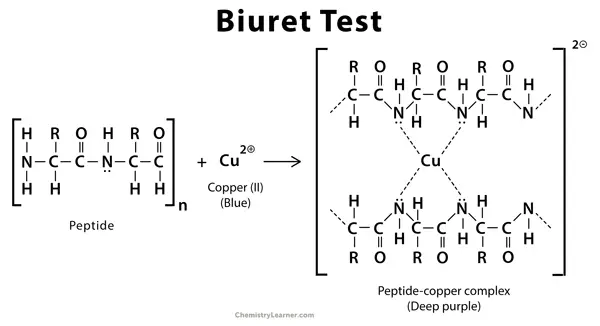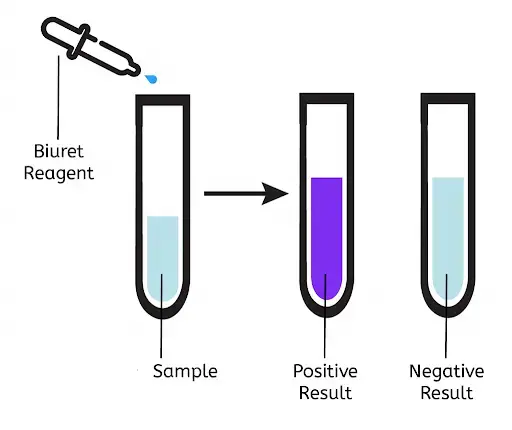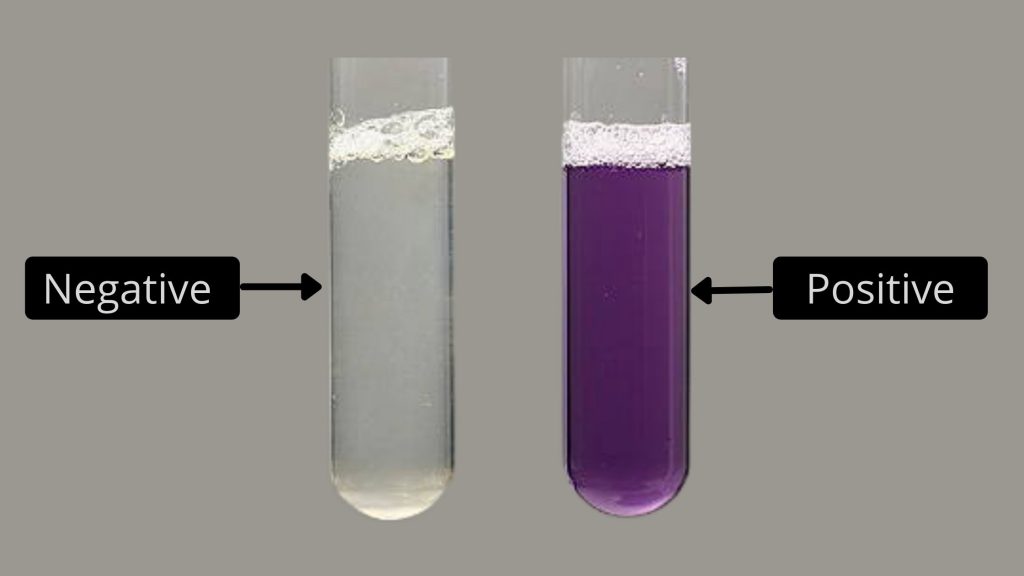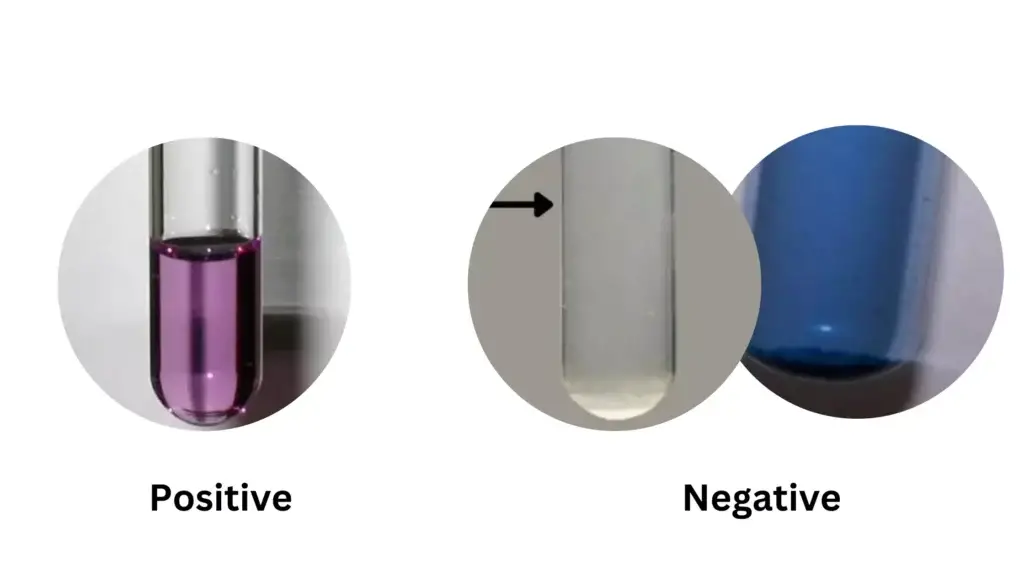Contents
What is Biuret Test?
The Biuret test is a chemical test used to determine the presence of peptide bonds in a sample. It is named after the French chemist Jean Baptiste Biuret, who first described the reaction in 1884. The test involves adding a copper(II) ion solution (such as CuSO4) to a protein solution. If peptide bonds are present, a blue color will develop due to the formation of copper-peptide complexes. The intensity of the color is directly proportional to the concentration of protein present in the sample. The Biuret test is a qualitative test, meaning it can only indicate the presence or absence of protein, not the specific type or quantity.
Proteins are polymers of amino acids. They are complex organic compounds containing nitrogen, hydrogen, carbon, and oxygen. Proteins are abundant in our everyday food e.g. egg, soya bean, pulses, fish, milk etc. The presence of proteins can be confirmed qualitatively by using several tests, Biuret Test is one of them. Due to the presence of characteristic side chains in them, certain amino acids exhibit typical colour reactions that form the basis for their identification.
Biuret is created by heating urea at 180 degrees Celsius. The Biuret test is a chemical test that employs Biuret reagents, which include a 1% solution of Copper II sulphate (CuSO4). Cu2+ in the Biuret reagent produces a compound with protein peptide links. Therefore, this technique is useful for identifying peptide bonds in any substance. Peptide bonds are formed when two acids are linked by carbonyl and amino groups. In addition, the fundamental unit of protein is composed of amino acids joined by peptide bonds. Notably, this experiment is crucial, and students preparing for upcoming exams should have a thorough understanding of this chapter.
Key Facts
- This test also known as Piotrowski’s test.
- The biuret test is a chemical test that can be used to confirm the presence of peptide bonds in a given sample. Therefore, the biuret test can be also be used to gauge the amount of protein present in the sample.
- In this test, the presence of peptides results in the formation of pale purple coloured coordination compounds of the copper (II) ion (when the solution is sufficiently alkaline).
- It can also be recorded that the intensity of the purple colour and, hence, the absorption at 540 nm is directly proportional to the concentration of proteins in the given analyte (as a consequence of the Beer-Lambert law).
- A positive reaction for this test is also obtained when the sample carries biuret molecules ([H2N-CO]2NH) since the bonds in this molecule is related to peptide bonds.
Purpose of Biuret Test
- To detect the protein in the given solution.
- To confirm the presence of the peptide bond.
Principle of Biuret Test
The Biuret test is a widely used biochemical assay designed to detect the presence of proteins. This test is based on a colorimetric reaction, which means the presence of proteins is indicated by a visible color change. The principle of the Biuret test hinges on the interaction between cupric ions (Cu²⁺) and the peptide bonds in proteins under alkaline conditions.
Chemical Basis
The reaction involved in the Biuret test can be summarized as follows:
- Alkaline Environment: The Biuret reagent, which consists of copper sulfate (CuSO₄) and sodium hydroxide (NaOH), creates an alkaline environment necessary for the reaction to occur.
- Interaction with Peptide Bonds: In this alkaline environment, cupric ions (Cu²⁺) from the copper sulfate interact with the nitrogen atoms in the peptide bonds (-CO-NH-) of proteins.
- Formation of Coordination Complex: This interaction leads to the formation of a violet-colored copper coordination complex. The nitrogen atoms from the peptide bonds coordinate with the copper ions, resulting in a color change from blue to violet.
- Proportional Color Intensity: The intensity of the violet color is directly proportional to the number of peptide bonds present, and thus to the concentration of proteins in the sample.

Materials Requirements
- 1% alanine and 5% albumin or egg white (as positive control)
- Biuret reagents
- Deionised water (as negative control)
- Dry test tubes
- Water bath
- Pipettes
Biuret Reagent
- Biuret reagent is a type of solution which is composed of sodium hydroxide (NaOH), hydrated copper (II) sulfate, and potassium sodium tartrate.
- Sodium hydroxide provides the alkaline medium and potassium sodium tartrate is added to chelate and thus stabilize the cupric ions in the solution or to maintain their solubility in alkaline solution.
Copper sulphate (CuSO4), sodium hydroxide (NaOH), and sodium-potassium tartrate make up Biuret reagent (also known as Rochelle salt). This reagent does not contain Biuret ((H2N-CO)2NH, despite its name. It is essential to the Biuret protein assay.
Biuret Reagent Preparation
- Dissolve Copper(II) Sulfate:
- Measure 1 gram of Copper(II) sulfate (CuSO₄) crystals.
- Dissolve the CuSO₄ crystals in 100 mL of distilled water. This forms a 1% CuSO₄ solution.
- Add Sodium Potassium Tartrate:
- Measure 1.2 grams of sodium potassium tartrate.
- Add this to the CuSO₄ solution. Sodium potassium tartrate acts as a stabilizing agent, ensuring the cupric ions (Cu²⁺) remain in solution and do not precipitate.
- Prepare Sodium Hydroxide Solution:
- Weigh 10 grams of sodium hydroxide (NaOH) pellets.
- Dissolve the NaOH pellets in 90 mL of distilled water to create a 10% NaOH solution. This highly alkaline solution is necessary for the Biuret test reaction.
- Combine the Solutions:
- Add 10 mL of the 10% NaOH solution to the 100 mL of 1% CuSO₄ solution slowly, while stirring continuously. This step must be done carefully to ensure thorough mixing and prevent any local high concentrations that could lead to precipitation.
Importance of Each Component
- Copper(II) Sulfate (CuSO₄): Provides the cupric ions (Cu²⁺) that interact with the peptide bonds in proteins, leading to the characteristic color change.
- Sodium Potassium Tartrate: Stabilizes the cupric ions, preventing them from precipitating out of solution and ensuring they remain available to react with the proteins.
- Sodium Hydroxide (NaOH): Creates the necessary alkaline environment for the reaction to occur. The alkaline pH is crucial for the cupric ions to interact effectively with the peptide bonds.
Safety Considerations
- Copper(II) Sulfate: Handle with care as it is toxic if ingested and can cause skin and eye irritation.
- Sodium Hydroxide: Highly caustic and can cause severe burns. Always handle with appropriate personal protective equipment (PPE), such as gloves and safety goggles.
- General Laboratory Safety: Always follow standard laboratory safety protocols, including working in a well-ventilated area and disposing of chemical waste properly.
Keep In mind
- If the test specimen is solid, it must first be dissolved or liquefied.
- Do not shake the mixture.
- Using a spectrophotometer, measure the variations in colour. This is to determine the amount of protein present in a particular sample.
- There is a superior method for determining the protein content of a given sample. The modified biuret test is known as the Smith Assay. It multiplies by one hundred the sensitivity of the biuret test. It differs from the biuret test because its copper source is bicinchoninic acid. When protein is present, the substance immediately becomes purple.
- Protein levels in the urine or blood are unrelated to a high protein diet.
- The presence of magnesium and ammonium ions can influence Biuret test findings. In this circumstance, additional alkali is required.
Procedure of Biuret Test
- Label the Test Tubes:
- Prepare three test tubes and label them as ‘test’, ‘positive’, and ‘negative’ to clearly distinguish between the sample, positive control, and negative control.
- Dispense the Solutions:
- In the test tube labeled ‘test’, dispense 1-2 mL of the sample solution that you want to test for protein content.
- In the test tube labeled ‘positive’, dispense 1-2 mL of the albumin solution. Albumin is a well-known protein, which will serve as the positive control.
- In the test tube labeled ‘negative’, dispense 1-2 mL of distilled water. Distilled water, which contains no proteins, will serve as the negative control.
- Add Biuret Reagent:
- Using a pipette, add an equal volume (1-2 mL) of Biuret reagent to each of the three test tubes. Ensure the volumes are consistent across all test tubes to maintain accuracy.
- Mix the Solutions:
- Shake each test tube gently to mix the Biuret reagent thoroughly with the contents of the tube. This ensures that the reagent interacts uniformly with the sample or control solution.
- Incubate the Tubes:
- Allow the test tubes to stand at room temperature for 5 minutes. This incubation period lets the reaction between the Biuret reagent and any present proteins to occur fully.
- Observe the Results:
- After the incubation period, observe the test tubes for any color change. A violet or purple color indicates the presence of peptide bonds, thus confirming the presence of proteins.

Ammonium and magnesium ions frequently impede this test. However, extra alkali can be used to eliminate it.
Result and Interpretation of Biuret Test

Positive Biuret Test
- Observation: Formation of a violet or purple color in the sample solution after the addition of Biuret reagent.
- Interpretation: This indicates the presence of proteins or peptides in the sample. The intensity of the color can vary depending on the concentration of proteins present.
Negative Biuret Test
- Observation: No color change in the sample solution, or formation of a blue color, after the addition of Biuret reagent.
- Interpretation: This suggests the absence of proteins or peptides in the sample. The blue color indicates that there are no peptide bonds for the copper ions to react with, resulting in a negative test result.
Interpretation Guidelines
- Positive Result: If the sample solution turns violet or purple, it is reported positive for proteins or peptides.
- Negative Result: If the sample solution remains blue, even after 5 minutes of incubation with Biuret reagent, it is reported negative for proteins or peptides.
Importance of Controls
- Positive Control: Including a known protein solution (e.g., albumin) as a positive control ensures that the Biuret reagent is functioning correctly and can detect proteins.
- Negative Control: Using distilled water as a negative control helps confirm that any color change in the test sample is due to the presence of proteins, not the reagent or other contaminants.

How to Increase Biuret Test Sensitivity?
Cu+ is a powerful reducing agent that can react with Mo(VI) in the Folin-Ciocalteu test to form molybdenum blue. This technique primarily detects proteins with concentrations between 0.005 and 2 mg/mL. Molybdenum blue, on the other hand, can bind particular organic dyes such as malachite green and Auramine o. It results in further signal amplification.
Cu+ ions form a compound with BCA or bicinchoninic acid that is a deep purple colour. It enables the identification of proteins between 0.0005 and 2 mg/mL. This is also known as “Pierce assay” in honour of a maker of reagent kits.
Perform biuret test for protein using Fehling’s A and B solutions
- Ensure that you have freshly prepared Fehling’s A and B solutions. A is a solution of copper (II), whereas B contains solutions of sodium hydroxide and sodium potassium tartrate.
- When analysing a food sample, approximately 1 cm3 of solutions A and B must be added to the sample.
- As a negative control, repeat the aforementioned processes using de-ionized water. For positive controls, albumin or egg white should be used.
- Shake the mixture carefully and allow it to sit for five minutes.
- Watch for any colour changes.
Performing biuret test using copper sulphate and sodium hydroxide solutions
- Sodium hydroxide solution (1 cm3) and copper (II) sulphate solution (1%) are applied to food samples.
- To make a negative control, repeat the processes outlined previously using de-ionized water. The second is a positive control utilising albumin or egg white.
- Shake the mixture and let it to sit for approximately five minutes.
- Observe closely for any changes in hue.
Application of Biuret Test
The Biuret test is a widely used method for the detection of proteins in a variety of samples. Some of the common applications of the Biuret test include:
- Clinical Chemistry: The Biuret test is commonly used in clinical chemistry to measure the concentration of proteins in blood and urine samples. This can provide important diagnostic information about a patient’s health, such as kidney function and inflammation.
- Food Science: The Biuret test is used in the food industry to measure the protein content of food products. This can be used to verify the nutritional value of the product and ensure that it meets regulatory standards.
- Agriculture: The Biuret test is used in agriculture to measure the protein content of animal feed. This can be used to ensure that the feed is nutritionally balanced and meets regulatory standards.
- Biotechnology: The Biuret test is used in biotechnology to measure the concentration of proteins in cell culture samples, fermentation broths, and other biological fluids.
- Research: The Biuret test is used in research to measure the concentration of proteins in samples such as plant extracts, animal tissues and fluids, and recombinant proteins.
- Environmental Science: Biuret test can be used to detect proteins in environmental samples such as water, soil and air.
- Drug Development: Biuret test can be used to detect proteins in samples from drug development such as purified proteins, serum, urine and other biological fluids.
- Quality Control: Biuret test is used in industries such as pharmaceuticals, cosmetics, and others to check the quality of their products.
Biuret Test is used to detect the amount of protein in the urine. Biuret reaction with protein is applicable to the quantitative determination of total protein by spectrophotometric analysis.
The biuret test is a chemical reaction used to identify whether a solution contains peptide or protein molecules. When the biuret reagent combines with peptide or protein molecules, a blue hue is created. The intensity of the blue colour in a solution is proportional to the concentration of peptide or protein molecules.
The biuret test can identify the presence of peptide or protein molecules in a wide range of substances, including:
- Foods \sBeverages
- Proteins in bodily fluids
- Proteins in clinical samples
The biuret test can detect the presence of peptide or protein molecules in a wide range of foods, including:
- Milk \sCheese \sEggs \sMeat
The biuret test can be used to determine the presence of peptide or protein molecules in beverages such as:
- Beer \sWine \sSoda \sJuice
The biuret test can identify the presence of peptide or protein molecules in various bodily fluids, such as:
- Urine \sBlood \sSaliva
The biuret test can detect the presence of peptide or protein molecules in numerous medical specimens, including:
- Urine \sBlood \sSaliva \sSemen
Advantages of Biuret Test
- Simplicity and Speed: The Biuret test is a simple and quick method for detecting proteins. It requires minimal preparation and can be completed in a short amount of time, making it suitable for high-throughput analysis.
- Cost-Effectiveness: Compared to other protein assays, such as the Kjeldahl test, the Biuret test is less costly. This makes it a preferred choice for laboratories with budget constraints.
- Stable Color Reaction: The Biuret test produces a stable color reaction, which is important for accurate and consistent results. Unlike some other protein assays that may result in variations over time, the color change in the Biuret test remains stable.
- Few Interfering Substances: The Biuret test is relatively specific for proteins and peptides. It is less likely to be interfered with by other substances present in the sample, reducing the risk of false-positive or false-negative results.
- Specificity for Protein Nitrogen: The Biuret test specifically detects nitrogen in protein or peptide bonds. It does not detect non-protein nitrogen, providing a more accurate measurement of protein content in the sample.
Limitation of Biuret Test
- Sensitivity: The Biuret test is less sensitive compared to other protein assays, such as the Folin-Lowry test. It requires at least 2-4 mg of protein to produce a detectable color change, which may limit its utility for samples with low protein concentrations.
- Interference by Ammonium Salts and Bile Pigments: High concentrations of ammonium salts and bile pigments can interfere with the Biuret test, leading to inaccurate results. Care must be taken to minimize the presence of these substances in the sample.
- Variability in Color Reaction: The Biuret test can produce different hues of color for different proteins. For example, gelatin may produce a pink-purple tint, while other proteins may result in different shades of violet. Additionally, carbohydrates and fats can reduce the clarity of the color reaction, making it difficult to interpret the results accurately.
- Requirement for Solubility: The Biuret test requires that proteins be soluble in the test solution. Insoluble proteins may not produce a detectable color change, leading to false-negative results.
- Lack of Standardization: The Biuret test is not a definitive test for protein quantification. The colors produced in the test must be standardized against well-characterized proteins, such as bovine serum albumin (BSA), to accurately determine protein concentrations.
- Speed of Reaction: While the Biuret test is relatively quick, it can be further accelerated by heating the sample or adding 30% isopropyl alcohol. These modifications can shorten the reaction time from 35 to 10 milliseconds, but care must be taken to ensure that the modifications do not interfere with the accuracy of the test.
What are the precautions needed for performing the biuret test?
When performing the Biuret test, it’s important to take some precautions to ensure accurate and reliable results. Some of the precautions include:
- Proper handling of reagents: The Biuret reagent should be prepared fresh, and stored in a cool, dark place to prevent contamination or decomposition.
- Sample preparation: The sample should be homogenized and diluted properly to obtain accurate results.
- Control sample: A control sample without protein should be used to compare the results with the test samples.
- Use of clean glassware: Glassware should be cleaned thoroughly to prevent any interference from previous experiments or impurities.
- Proper measurement of reagents: The reagents should be measured accurately to obtain consistent results.
- Timing: The test should be carried out in a time-controlled manner, as the color change is usually transient and is best observed within a few minutes of adding the reagent.
- Lighting condition: The color change should be observed in good lighting conditions, to avoid any errors in the interpretation of the results.
- The biuret reagent is basic and toxic, therefore, it should be handled with care and appropriate safety measures should be taken.
- Since the test is not specific for proteins, it should be used with other methods such as SDS-PAGE to confirm the presence and the identity of proteins in the samples.
FAQ
What is the composition of the Biuret reagent?
The Biuret reagent is a solution of copper(II) sulfate (CuSO4) and sodium hydroxide (NaOH). The exact composition can vary depending on the specific use or application, but typically it is a 1% to 2% solution of CuSO4 in aqueous NaOH.
Why is it important to detect the presence of protein in a given type of fluid?
The detection of protein in a given type of fluid can be important for a variety of reasons. One common application is in the field of clinical chemistry, where the presence and concentration of proteins in blood and urine can provide important diagnostic information about a patient’s health. For example, an increase in the level of certain proteins, such as creatinine or blood urea nitrogen (BUN), can indicate kidney dysfunction, while an increase in the level of other proteins, such as C-reactive protein (CRP) can indicate inflammation or infection. In addition to its diagnostic role, protein detection can also be used in industries such as food and agriculture where detecting the presence of protein in food products or animal feed can be used to verify the nutritional value of the product.
Why does biuret turn purple in the presence of protein?
The Biuret reagent turns purple in the presence of protein because of the way the protein molecules interact with the copper ions in the reagent. In the Biuret reagent, copper ions are present in a complex with four water molecules (Cu(H2O)4^2+). When a protein is added to the reagent, the peptide bonds in the protein can coordinate with the copper ions, causing the formation of a complex between the protein and the copper ions. This complex absorbs light at a different wavelength than the original Cu(H2O)4^2+ ions, resulting in a change in color from a pale blue to a deep purple.
It is important to note that Biuret test is not a specific test for proteins, it gives a positive reaction for other compounds that have peptide bonds such as some dipeptides and tripeptides, and even some non-peptide compounds such as urea.
What is the composition of the Biuret reagent?
The Biuret reagent is typically a 1% to 2% solution of copper(II) sulfate (CuSO4) in aqueous sodium hydroxide (NaOH).
What is the Biuret test used for?
The Biuret test is used to detect the presence of proteins in a sample by measuring the change in color of a copper-containing reagent in the presence of peptide bonds.
How does the Biuret test work?
The Biuret test works by measuring the change in color of the reagent in the presence of protein. Peptide bonds in the protein coordinate with the copper ions in the reagent, causing a change in color from pale blue to deep purple.
What are the advantages of the Biuret test?
The Biuret test is simple, inexpensive, and can be used to detect proteins in a wide range of samples. It is also a common test used in many laboratory settings.
What are the limitations of the Biuret test?
The Biuret test is not specific for proteins and can give a positive reaction for other compounds that have peptide bonds such as some dipeptides and tripeptides, and even some non-peptide compounds such as urea.
What sample types can be tested with the Biuret test?
The Biuret test can be used to detect proteins in a wide range of samples, including blood, urine, food, and agricultural products.
How accurate is the Biuret test?
The accuracy of the Biuret test can vary depending on the sample type and the specific application. It is usually recommended to use other methods such as SDS-PAGE to confirm the presence and the identity of proteins in the samples.
How should the Biuret reagent be stored?
The Biuret reagent should be stored in a cool, dark place to prevent contamination or decomposition.
How should the samples be prepared before performing the Biuret test?
The samples should be homogenized and diluted properly to obtain accurate results.
What are the precautions that should be taken when performing the Biuret test?
Proper handling of reagents, sample preparation, use of clean glassware, accurate measurement of reagents, timing, lighting conditions, and safety measures should be taken in order to obtain accurate and reliable results.
References
- https://www.mlsu.ac.in/econtents/2207_Biuret%20test.pdf
- https://himedialabs.com/td/htbc004.pdf
- https://www.onlinebiologynotes.com/biuret-test-principle-requirements-reagents-preparation-procedure-and-result/
- http://dept.harpercollege.edu/chemistry/chm/100/dgodambe/thedisk/food/biuret/biuret.htm
- https://laboratoryinfo.com/biuret-test/?fbclid=IwAR0s9bxjWuJMY7Jjrdi1P_hhTi1VRaci9hbuxn-0NcbZ6U2JyUhuTd_ACyU
- https://www.vedantu.com/chemistry/biuret-test
- https://www.sciencedirect.com/topics/biochemistry-genetics-and-molecular-biology/biuret-reaction
- https://www.biologyonline.com/dictionary/biuret-test
- http://brilliantbiologystudent.weebly.com/biuret-test-for-protein.html
- https://microbenotes.com/biuret-test-for-protein/











